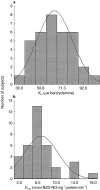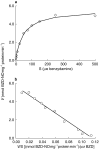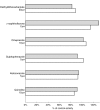Benzydamine N-oxidation as an index reaction reflecting FMO activity in human liver microsomes and impact of FMO3 polymorphisms on enzyme activity
- PMID: 11136294
- PMCID: PMC2015007
- DOI: 10.1046/j.1365-2125.2000.00296.x
Benzydamine N-oxidation as an index reaction reflecting FMO activity in human liver microsomes and impact of FMO3 polymorphisms on enzyme activity
Abstract
Aims: The role of flavin containing monooxygenases (FMO) on the disposition of many drugs has been insufficiently explored. In vitro and in vivo tests are required to study FMO activity in humans. Benzydamine (BZD) N-oxidation was evaluated as an index reaction for FMO as was the impact of genetic polymorphisms of FMO3 on activity.
Methods: BZD was incubated with human liver microsomes (HLM) and recombinant enzymes. Human liver samples were genotyped using PCR-RFLP.
Results: BZD N-oxide formation rates in HLM followed Michaelis-Menten kinetics (mean Km = 64.0 microM, mean Vmax = 6.9 nmol mg-1 protein min-1; n = 35). N-benzylimidazole, a nonspecific CYP inhibitor, and various CYP isoform selective inhibitors did not affect BZD N-oxidation. In contrast, formation of BZD N-oxide was almost abolished by heat treatment of microsomes in the absence of NADPH and strongly inhibited by methimazole, a competitive FMO inhibitor. Recombinant FMO3 and FMO1 (which is not expressed in human liver), but not FMO5, showed BZD N-oxidase activity. Respective Km values for FMO3 and FMO1 were 40.4 microM and 23.6 microM, and respective Vmax values for FMO3 and FMO1 were 29.1 and 40.8 nmol mg-1 protein min-1. Human liver samples (n = 35) were analysed for six known FMO3 polymorphisms. The variants I66M, P135L and E305X were not detected. Samples homozygous for the K158 variant showed significantly reduced Vmax values (median 2.7 nmol mg-1 protein min-1) compared to the carriers of at least one wild type allele (median 6.2 nmol mg-1 protein min-1) (P < 0.05, Mann-Whitney-U-test). The V257M and E308G substitutions had no effect on enzyme activity.
Conclusions: BZD N-oxidation in human liver is mainly catalysed by FMO3 and enzyme activity is affected by FMO3 genotype. BZD may be used as a model substrate for human liver FMO3 activity in vitro and may be further developed as an in vivo probe reflecting FMO3 activity.
Figures






Similar articles
-
In vitro evaluation of potential in vivo probes for human flavin-containing monooxygenase (FMO): metabolism of benzydamine and caffeine by FMO and P450 isoforms.Br J Clin Pharmacol. 2000 Oct;50(4):311-4. doi: 10.1046/j.1365-2125.2000.00265.x. Br J Clin Pharmacol. 2000. PMID: 11012553 Free PMC article.
-
Drug oxygenation activities mediated by liver microsomal flavin-containing monooxygenases 1 and 3 in humans, monkeys, rats, and minipigs.Biochem Pharmacol. 2014 Jul 15;90(2):159-65. doi: 10.1016/j.bcp.2014.04.019. Epub 2014 May 10. Biochem Pharmacol. 2014. PMID: 24821112
-
Benzydamine N-oxygenation as an index for flavin-containing monooxygenase activity and benzydamine N-demethylation by cytochrome P450 enzymes in liver microsomes from rats, dogs, monkeys, and humans.Drug Metab Pharmacokinet. 2015 Feb;30(1):64-9. doi: 10.1016/j.dmpk.2014.09.006. Epub 2014 Oct 5. Drug Metab Pharmacokinet. 2015. PMID: 25760531
-
Human flavin-containing monooxygenase (form 3): polymorphisms and variations in chemical metabolism.Pharmacogenomics. 2002 May;3(3):325-39. doi: 10.1517/14622416.3.3.325. Pharmacogenomics. 2002. PMID: 12052141 Review.
-
Mammalian flavin-containing monooxygenases: structure/function, genetic polymorphisms and role in drug metabolism.Pharmacol Ther. 2005 Jun;106(3):357-87. doi: 10.1016/j.pharmthera.2005.01.001. Pharmacol Ther. 2005. PMID: 15922018 Free PMC article. Review.
Cited by
-
Assessment of In Silico and In Vitro Selpercatinib Metabolic Stability in Human Liver Microsomes Using a Validated LC-MS/MS Method.Molecules. 2023 Mar 14;28(6):2618. doi: 10.3390/molecules28062618. Molecules. 2023. PMID: 36985590 Free PMC article.
-
An Ultra-Fast Validated Green UPLC-MS/MS Approach for Assessing Revumenib in Human Liver Microsomes: In Vitro Absorption, Distribution, Metabolism, and Excretion and Metabolic Stability Evaluation.Medicina (Kaunas). 2024 Nov 21;60(12):1914. doi: 10.3390/medicina60121914. Medicina (Kaunas). 2024. PMID: 39768795 Free PMC article.
-
Genetic polymorphisms of human flavin-containing monooxygenase 3: implications for drug metabolism and clinical perspectives.Pharmacogenomics. 2007 Jun;8(6):635-43. doi: 10.2217/14622416.8.6.635. Pharmacogenomics. 2007. PMID: 17559352 Free PMC article. Review.
-
Functional characterization of genetic variants of human FMO3 associated with trimethylaminuria.Arch Biochem Biophys. 2007 Aug 15;464(2):251-9. doi: 10.1016/j.abb.2007.04.014. Epub 2007 May 2. Arch Biochem Biophys. 2007. PMID: 17531949 Free PMC article.
-
Inhibition of Nicotine Metabolism by Cannabidiol (CBD) and 7-Hydroxycannabidiol (7-OH-CBD).Chem Res Toxicol. 2023 Feb 20;36(2):177-187. doi: 10.1021/acs.chemrestox.2c00259. Epub 2023 Jan 10. Chem Res Toxicol. 2023. PMID: 36626330 Free PMC article.
References
-
- Poulsen LL, Ziegler DM. Multisubstrate flavin-containing monooxygenases: applications of mechanism to specificity. Chem Biol Interact. 1995;96:57–73. - PubMed
-
- Ziegler DM. Recent studies on the structure and function of multisubstrate flavin- containing monooxygenases. Annu Rev Pharmacol Toxicol. 1993;33:179–199. - PubMed
-
- Ziegler DM. Flavin-containing monooxygenases: catalytic mechanism and substrate specificities. Drug Metab Rev. 1988;19:1–32. - PubMed
-
- Cashman JR, Park SB, Berkman CE, Cashman LE. Role of hepatic flavin-containing monooxygenase 3 in drug and chemical metabolism in adult humans. Chem Biol Interact. 1995;96:33–46. - PubMed
-
- Lawton MP, Cashman JR, Cresteil T, et al. A nomenclature for the mammalian flavin-containing monooxygenase gene family based on amino acid sequence identities. Arch Biochem Biophys. 1994;308:254–257. - PubMed
Publication types
MeSH terms
Substances
LinkOut - more resources
Full Text Sources
Other Literature Sources
Miscellaneous

